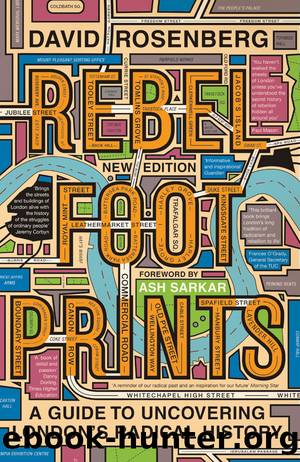Rebel Footprints - Second Edition by David Rosenberg

Author:David Rosenberg [Rosenberg, David]
Language: eng
Format: epub
ISBN: 9781786804150
Google: GA5dyQEACAAJ
Publisher: Pluto Press
Published: 2019-01-15T01:11:13+00:00
WALK
Start at St Leonardâs Church, Shoreditch High Street, E1 6JN
1. Shoreditch High Street
St Leonardâs Church is the latest incarnation of churches that have stood on this spot for more than 900 years. This one was built in 1740. The nursery rhyme words, âWhen I grow rich, say the bells of Shoreditchâ, refers to this church. Behind it lies Boundary Street. This separates Shoreditch from the Bethnal Green parish of St Matthews in Tower Hamlets, which, until the 1890s, comprised the infamous Old Nichol slum. Sensationalist and derogatory newspaper depictions of this district were strongly reinforced by Arthur Morrisonâs social realist novel Child of the Jago, researched in the Old Nichol. Turn right out of the churchyard, and pause at Austin Street. On the right, behind the church gardens, is a sign for Boundary Street, forming one edge of the Old Nichol. The anarchist agitator and founder of the No Rent Campaign, Charles Mowbray, ran a print shop with his comrade Frank Kitz on this street. Bear right into Hackney Road, then right again into Columbia Road.
2. Columbia Road
An impressive block of flats with black metalwork stands on the right. These are the Leopold Buildings built by Sidney Waterlow, who developed the semi-philanthropic âImproved Industrial Dwellings Companyâ which built tenements in five areas of London. These tenements were targeted towards âmorally upstandingâ families of skilled workers. Waterlowâs buildings were criticised by some for âprison-like architectureâ. When the London County Council (LCC) cleared the Old Nichol and built Londonâs first large-scale council housing estate nearby â the Boundary Estate â it knew it had at least to match the room size and quality set by Leopold Buildings. Continue to the corner of Gascoigne Road.
3. Corner Columbia Road/Gascoigne Road
Columbia Road is famous for its flower market. In the distance stands the Birdcage pub. Historically, cut flowers and caged birds were merchandise typically sold by Huguenots. Gascoigne Road, with its French name, is a further indication of the historical Huguenot presence, which included many weavers. Walk along Gascoigne Road, turn left, then immediately right again into Swanfield Street. You soon get your first glimpse of the tall red-brick buildings on the right-hand side that comprise the north-eastern edge of the Boundary Estate. Just behind the flats (Sunbury Buildings) you will see a row of low-rise structures called âSunbury workshopsâ. Built as an integral part of the estate, they indicate that artisan grades of the working classes were the preferred tenants. In 1909, a gathering took place in the home of Nathan Weiner, a cabinet-maker living in Sunbury Buildings. It was the first meeting of the Arbeter Ring, a left-wing friendly society formed by Yiddish-speaking Jewish immigrants (discussed in greater detail in Chapter 4). Continue along Swanfield Street.
4. Swanfield Street
A striking-looking old building appears on the left. At street level are the premises of a Mauritian-born foam and mattress seller. The building was once a weaverâs cottage. Turn left then right into the smaller northern section of Brick Lane.
5. Brick Lane/Padbury Court
Stop on the corner of Padbury Court, a narrow street of uniformly built houses.
Download
This site does not store any files on its server. We only index and link to content provided by other sites. Please contact the content providers to delete copyright contents if any and email us, we'll remove relevant links or contents immediately.
In Cold Blood by Truman Capote(3311)
The Innovators: How a Group of Hackers, Geniuses, and Geeks Created the Digital Revolution by Walter Isaacson(2849)
Steve Jobs by Walter Isaacson(2837)
All the President's Men by Carl Bernstein & Bob Woodward(2332)
Lonely Planet New York City by Lonely Planet(2173)
And the Band Played On by Randy Shilts(2132)
The Room Where It Happened by John Bolton;(2106)
The Poisoner's Handbook by Deborah Blum(2094)
The Murder of Marilyn Monroe by Jay Margolis(2059)
The Innovators by Walter Isaacson(2057)
Lincoln by David Herbert Donald(1949)
A Colony in a Nation by Chris Hayes(1881)
Under the Banner of Heaven: A Story of Violent Faith by Jon Krakauer(1750)
Amelia Earhart by Doris L. Rich(1650)
The Unsettlers by Mark Sundeen(1647)
Being George Washington by Beck Glenn(1631)
Birdmen by Lawrence Goldstone(1621)
Dirt by Bill Buford(1613)
Zeitoun by Dave Eggers(1594)
